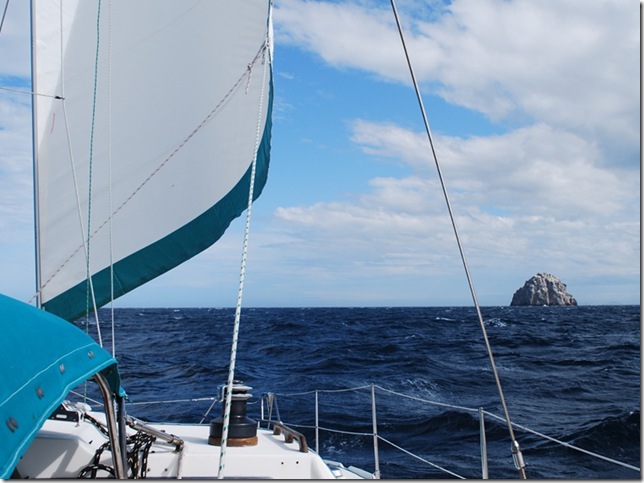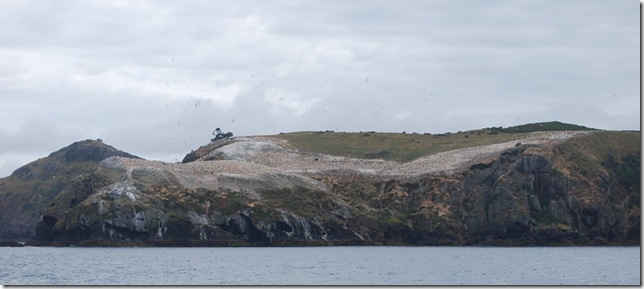Lat: 36 18.086′ S
Lon: 175 21.989′ E
We had plenty of wind on our way to Great Barrier Island. Some good sized seas built up, but we were going with them, which makes all the difference. After sailing by Poor Knights Islands, we passed right between Sugarloaf Rock and High Peak Rocks. I have no idea what sugarloaf means, but it was apparently popular when English geographical names were getting dished out here in NZ, as there’s no shortage of sugarloaf features.
We generally never ever come into a new place at night. It’s a common rule among sailors as there are just too many hazards that aren’t on the charts (mooring buoys, anchored boats, etc) or are charted poorly, or have been added since the chart was made. However, we were making such good time that we were going to get in at 1:30 am, a couple of hours before moonset. With the bright moonlight and the selection of a protected cove off of an open, deep bay to anchor in, we decided to give it a shot. Of course, right as we started to enter the mouth of the bay the moon went behind thick clouds and we noticed that there was a light fog in the bay. The light from the 800,000 candle power spotlight we were going to use as our "headlight" just reflected off of the moisture in the air instead of letting us see what was in the water ahead. Luckily, the wind was blowing the fog into the opposite reaches of the bay, so it cleared up a bit as we motored into Nagle Cove. We managed to anchor in a safe place with only one close call with a mooring buoy.
The next morning we woke up to the sound of sheep that were grazing on the hillside. Great Barrier is a rugged, verdant island with large, calm bays surrounded by towering ridge lines. The mountains are generally covered with a variety of trees, but some have been cleared for grazing and are a bright, rolling green among the darker green of the forest. Small steep-sided rocky islands are spread along its western coast. After breakfast we did a bit of work, topping off the water in the batteries and troubleshooting the nav lights. They drew over 20 amps when I had turned them on the night before (shorted out somewhere, really need to add a fuse) and so we sailed with anchor and steaming lights on instead. The problem turned out to be a short in the red port light that toasted the wiring and melted part of the plastic packaging. It may or may not be repairable, so we’re short one of our nav lights for tonight’s sail.
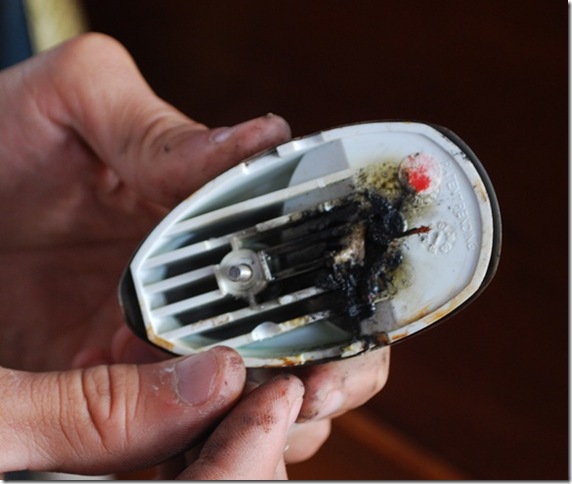 What 20 amps looks like the next day
What 20 amps looks like the next day
Next we motored over to Forestry Bay, which is a small, quiet bay next to the "metropolitan" Port Fitzroy bay and started work on the steering. It’s been on the list for a while and we were hoping to work on it later, but the wheel was making a loud squeaking sound most of the way down and it was getting hard to turn, which is hard on the autopilot (our most valuable piece of gear aside from GPS). We debated disconnecting the wheel and just using the autopilot (attached to the rudder quadrant) and the emergency tiller or just hand steering the last 24 hours, but decided to have a go at servicing the steering instead. Unfortunately, servicing the steering wasn’t really a high priority for the boat designer. The pieces I needed to get to were basically at the top of a narrow, arm-length, chimney-like shaft with a greasy chain hanging down in the top half of it. Driving out the locking pin just wasn’t going to happen without cutting an access hole under the compass, so I settled instead for a couple hours work in getting the wheel and hub off. The aluminum hub really didn’t want to let go of the stainless shaft and key. For any boaters out there, PB Blaster works wonders, but any stainless/aluminum interfaces really need to be coated with something like Tef-Gel or Duralak to have any hope of coming apart in the future. Luckily, all the banging, PB Blaster, and WD-40, as well as some dry lubricant sprayed into the shaft/bearing crack seemed to do well enough for now. The squeaking stopped and it’s much easier to turn the wheel.
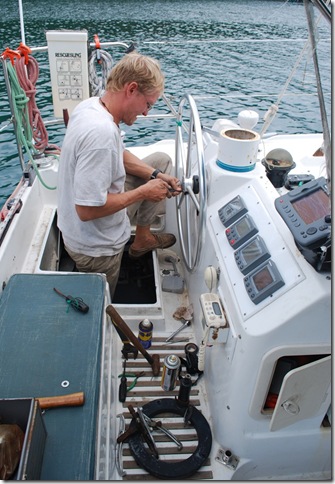 In the midst of several frustrating hours trying to disassemble the steering
In the midst of several frustrating hours trying to disassemble the steering
After all that fun, we headed ashore for a nice tramp (hike) to a waterfall on one of the many tracks (trails) here on the island. The NZ DoC (Department of Conservation) is really second to none in terms of the number and quality of tracks they maintain throughout the country. This one gave us a nice walk through the forest and eventually lead to Port Fitzroy. Even though the NZ anchorages book we found made it sound almost like a major metro, none of the three "restaurants" were open on Sunday and the general store was already closed, so we had to settle for a nice walk back to the boat and a great pasta dinner at sunset. With the cold nights here, we’ve started closing up the boat before Lauren cooks dinner so that the heat from the stove warms the boat up enough to make it comfortable until we dive under the blankets.
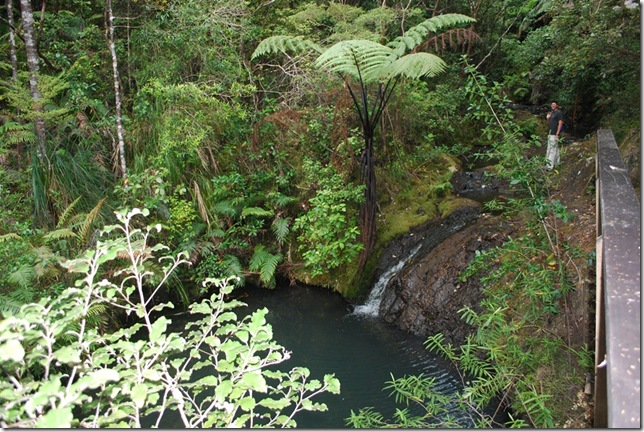 Small waterfall along the verdant track
Small waterfall along the verdant track
This morning we got up early and headed out through Man O’ War passage to sail the last 100 nm or so to Tauranga. NZ does have some incredible cruising grounds (the anchorage guide we bought lists 400 mainland and island anchorages just between North Cape and East Cape), but coastal cruising takes a bit of getting used to. There are land and boat traffic hazards to avoid, crayfish (lobster) traps to dodge, changing weather to keep track of, and tides and landfalls to time appropriately. Aside from the self-sufficiency aspects, it really does seem more challenging to coastal cruise (especially an area with shoals and reefs) than to make a tradewind ocean passage. The other big difference is that quite surprisingly, I’ve had connectivity for my Blackberry (now loaded with an NZ sim card) the whole way! The simple life is nice, but as Lauren will attest, I do love my Blackberry.
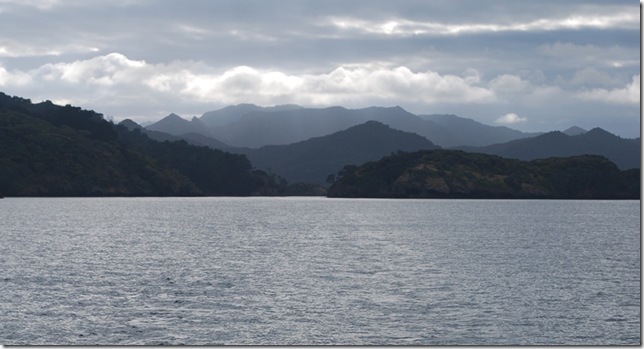 The early morning view back into Man ‘O’ War passage
The early morning view back into Man ‘O’ War passage
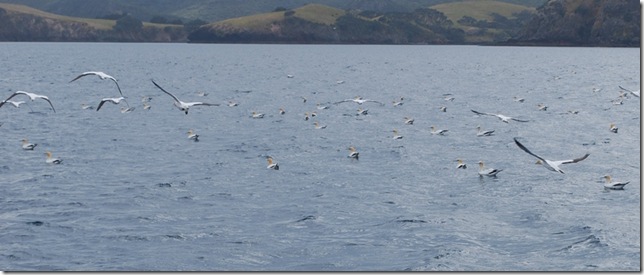 We were sailing so slowly that these birds didn’t bother to move until we were pretty close
We were sailing so slowly that these birds didn’t bother to move until we were pretty close


